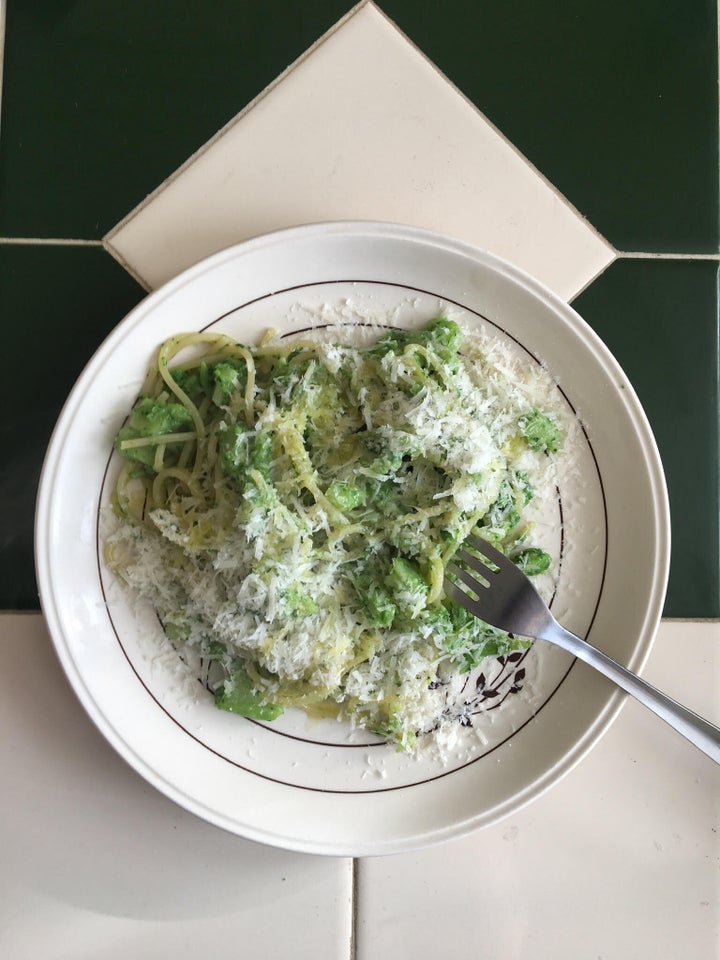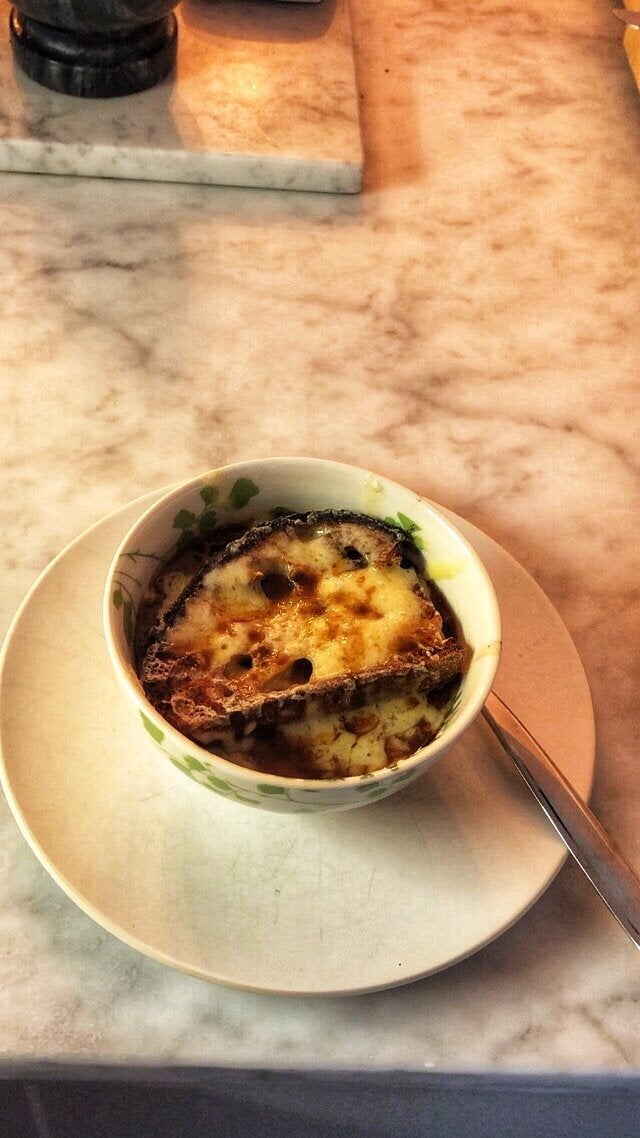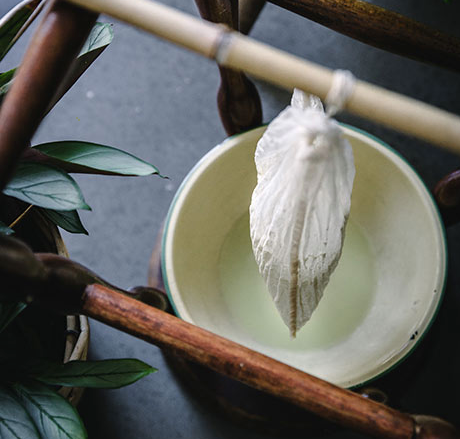We’re here to guide you through the coronavirus lockdown. Sign up to the Life newsletter for daily tips, advice, how-tos and escapism.
Since lockdown came into effect last month, procuring certain staple ingredients such as eggs and flour have become about as hard to find as hand sanitiser. Panic buying means many have more than they need, which in turn risks more food waste.
But this needn’t be the case. Give old ingredients from the back of the fridge a new lease of life, transform them into something delicious and don’t waste a drop, crumb or leaf of what’s in your kitchen.
We spoke to three zero-waste chefs for their recipes that make the most of underused, wilting or stale items for sustainable eating.
Pasta with Broccoli Smush
Serves: 2 | Prep time: 20 mins | Cooking time: 5 mins

This southern Italian way with pasta works with pretty much any green vegetable but using the stalks of broccoli or cauliflower gives a satisfying creaminess to the sauce, as well as a pleasing efficiency. Depending on the size of your broccoli this will probably make more smush than you need – the leftovers are very good on toast.
Ingredients:
150g pasta (spaghetti, penne, orecchiette)
1 head of broccoli
A good splash of extra virgin olive oil
4 salted anchovy fillets
2 cloves of garlic, thinly sliced
1 dried chilli
50g grated pecorino, plus more to serve
Method:
1. Put a large pan of salted water on to boil. Separate the florets from the broccoli, slice them in half and put to one side. Cut the stalk in quarters lengthways and then into slices as thick as a pound coin.
2. In a shallow pan big enough to hold all the pasta, gently heat the oil with the anchovy, garlic and chilli until the anchovy melts and the garlic begins to sizzle. Fish out the chilli.
3. When the water comes to a fast boil add the stalk and cook for five minutes, then add the florets and cook for three minutes more. Scoop all the broccoli out of the water with a slotted spoon straight into the sizzling oil, followed by a splash of the cooking water.
4. Bring the water back to the boil and cook the pasta until al dente (two minutes less than the packet says is a good rule). While it cooks, keep the broccoli at a simmer, crushing it with a wooden spoon and adding a splash more water if it dries out. By the time the pasta cooks, you should have a pale green cream.
5. Drain the pasta, keeping a mug of the starchy cooking water, and add to the broccoli pan with the grated cheese. Toss well, adding a splash or two of the cooking water to loosen and emulsify the sauce. Check the seasoning and serve with more grated cheese.
Recipe from Thom Eagle, Chef at The Little Duck, a fermenting kitchen and wine bar in East London. His new cookbook Summer’s Lease: How to Cook Without Heat, published by Quadrille in Hardback at £16.99 is out June 2020.
French Onion Soup
Serves: 3-4 | Prep time: 15 mins | Cooking time: 55 mins

A storecupboard French onion soup, which can be made with only a handful of ingredients and the flavours are so hearty and rich. It’s also a great way of using the ends of things that might otherwise have gone to waste such as sourdough that might be going a little stale or a block of cheddar that’s been sitting in the fridge. This recipe brings back great memories, I actually learnt it from Raymond Blanc when I worked at Belmond Le Manoir aux Quat’Saisons, from the great man himself.
Ingredients:
50g butter
2 kg onions, I used a mix of shallot, white and red onion (peeled and sliced thin)
4 cloves garlic (peeled and sliced thin)
300 ml white and red wine (boiled for 2 minutes or reduced by 1/3)
1.2 litre chicken or vegetable stock
Salt and I like to use a generous pinch of white pepper
A dash of Worcester sauce
Splash of sherry
2 bay leaves
2 sourdough slices
150g gruyere or a good cheddar, grated
Method:
1. Take a wide bottomed pan and place on a medium to high heat, add the butter and once melted and foaming adds the garlic and all the onions, add the salt and stir, cover with a lid and continue to stir, the salt will help extract the moister from the onions after 10 minutes remove the lid and turn the heat to halfway.
2. Continue to cook and use a flat wooden spoon to scrape the caramelised areas of the bottom of the pan. This may take up to an hour to get a lovely dark golden brown colour, a good tip is to take the pan off the heat and the steam will help deglaze the pan, this is where all the flavour is.
3. When happy with the onions, add a splash of Worcestershire sauce and the sherry, add the bay and wine, cook for 5 minutes, then add the stock and simmer for 15 minutes.
4. Heat through the soup set the grill on high, toast the sliced bread pour soup into the bowl, float the toast on top and cover with the grated cheese, place the bowls under the grill until the cheese melts.
Recipe from Robin Gill, Head Chef and Director at The Dairy, Sorella and Darby’s, a group of small-plate dining restaurant in various London locations with a seasonal menu.
Ricotta Dumplings
Serves: 2 | Prep time: Cheese 10 hours, Dumplings 15 mins | Cooking time: 30 mins

If you’re like me and drink a lot of black coffee, then this recipe is a great shout for using up any milk surplus taking up valuable quarantine fridge space. The ricotta will keep for around 3-5 days, it’s incredibly delicious and you get lots of bonus points for making your own cheese. Take a bow.
Ingredients:
For the ricotta:
1 litre milk
20ml White distilled vinegar or lemon juice
Pinch of salt
For the dumplings:
300g of homemade ricotta
Pinch of nutmeg
250g fine semolina
30g of Pecorino or Parmesan cheese, finely grated
1 egg yolk
Method:
1. Heat the milk to 93 degrees and stir in the vinegar or lemon juice. Stir the mixture together and allow the pan to sit for around 10-15 minutes.
2. Separate the curds from the whey and place into cheesecloth. If you don’t have muslin/cheesecloth, you can alternatively use a fine sieve.
3. Leave the curds hanging for around 10 hours. The longer you leave the curds, the firmer your ricotta will be. Taking it off earlier can result in a softer end product which is great on toast with lots of cracked pepper.
4. In a bowl, mix the ricotta, finely grated pecorino, egg yolk and nutmeg together. Season with salt and pepper. At this point, feel free to get creative and chuck some extra flavour in. Whatever tickles your fancy: chopped herbs, fresh chilli and lemon zest.
5. Wet your hands. This is going to make your life much easier to form nice little balls out of your mixture. Put the fine semolina into a tray and place next to your bowl. Place another tray next to this.
6. Roll the balls in the semolina and generously coat ensuring there are no patches where the ricotta is still visible. This will ensure an even skin all the way around your dumpling once set.
7. Place all of your finished dumplings onto a clean tray and dust with extra semolina. Refrigerate for 12 hours in the fridge to allow the semolina to set around the ricotta.
8. Drop into a pot of salted boiling water for around 2-3 minutes or until they float. Serve.
Recipe from Matthew Scott, Head Chef at Cub, a sustainable restaurant in East London.
